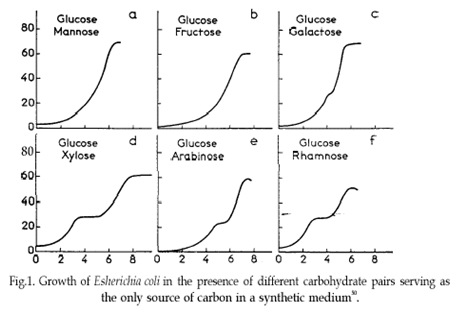Team:Imperial College London/Temporal Control/Autoinduction/Diauxic Growth
From 2009.igem.org

Diauxic Growth
When several carbon sources are present in a cell culture, bacteria will preferentially consume some types before others. As described by Monod [1], bacteria will preferentially consume glucose, and enter an exponential growth phase. Once the glucose is used up, bacteria growth will first plateau off. After a lag period, it will switch to consumption of secondary carbon sources and enter a second exponential growth phase. The most commonly studied example of diauxic growth is the preference of glucose over lactose. This also applies for several other carbon sources, as shown below (Image from [1]):

How it works- catabolite repression of promoter
This is the phenomenon called catabolite repression, where a preferred carbon source represses other promoters by lowering intracellular cAMP levels.
The key link here to the observed diauxic growth pattern is that the external glucose concentration is inversely correlated with the intracellular cAMP levels. For a CRP-linked promoter, transcription requires help from an active CRP protein (responsive to cAMP).

When cAMP levels are low, the inactive CRP protein is unable to bind to the promoter. Therefore, transcription does not start. When cAMP levels are high, cAMP binds to inactive CRP protein and activates it. This active CRP protein will trigger the start of transcription.
References
[1]J Monod-The growth of bacterial cultures- Annual Reviews in Microbiology, 1949 - Annual Reviews





 "
"



